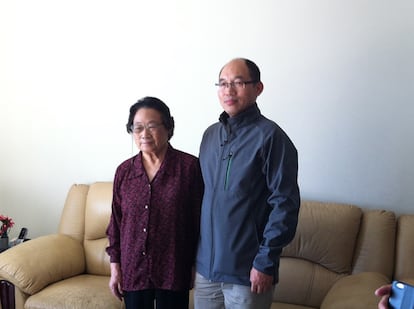Public funds being swallowed up by scientific journals with dubious articles
An analysis suggests that some academic publishers have multiplied their income thanks to accepting trivial studies en masse

A strange phenomenon has transformed the world scientific system. Suddenly, academic journals that were previously weekly or biweekly have started publishing several special issues each day. There are unusual cases, such as the hyperprolific environmental and health research journal International Journal of Environmental Research and Public Health (IJERPH), which last year published 17,000 scientific studies, 13 times more than in 2016, according to engineer Pablo Gómez Barreiro’s calculations. The theoretically biweekly journal has reached an output speed of six special issues per day and in recent years has been the preferred journal of Spanish scientists seeking to publish their work. The publishing house that owns it, MDPI, was founded in Switzerland by the Chinese chemist Shu-Kun Lin and has multiplied its income, thanks to a transfer of millions of euros of public money budgeted for science. It is a bubble that is about to burst, as a study by Gómez Barreiro and three other colleagues suggests.
“People with influence have to sit down and have an uncomfortable conversation, to decide the future of scientific publications, because, if this continues, we may lose the most important thing about science, which is scientific rigor. If you lose that, you lose everything,” warns Gómez Barreiro, who works at the Millennium Seed Bank at the Royal Botanic Gardens, Kew, in west London. The Spanish engineer is not a specialist in the academic system, but in 2018 he realized that scientists around him were publishing studies at an unusual rate. At the same time, his email inbox began to fill up with proposals from journals asking him to submit articles for imminent special issues, for a fee. Gómez Barreiro began to investigate what was happening and, via the internet, he came across three other colleagues who were also investigating: the Italian economist Paolo Crosetto, the Canadian immunologist Mark Hanson, and the British anthropologist Dan Brockington. They decided to join forces.
The quartet of amateur detectives, using sophisticated computer programs, extracted all the information available on the main international publishers’ websites. The team immediately found out that the number of studies published each year in the world had grown “exponentially,” exceeding 2.8 million in 2022, almost 50% more than just six years before.
Three publishers show particularly anomalous behavior, with a very high percentage of studies published in special issues: Frontiers, based in Switzerland (69%); Hindawi, based in London (62%), and above all, MDPI (88%), headquartered in Switzerland.
The four authors focus on the criteria by which scientists are evaluated before granting them funding, promotions, and salary increases. Their performance is measured practically by weight, by the number of published studies, in a system known as “publish or perish.” The quartet cites Goodhart’s law: if an indicator becomes the target, it is no longer a good indicator. The goal for many has been to publish studies, even if they were insubstantial. In other words, articles that are written once and no one ever reads.
Gómez Barreiro gives an extreme example: Professor Elsayed Tag Eldin, dean of the Faculty of Engineering at the University of the Future, a private institution in Cairo (Egypt) had barely published studies before, but this year he has already published 418, more than one every day, on all kinds of topics: Covid-19, solar panels, nanofluids, agriculture, even cyberattacks. He publishes more studies than anyone other scientist in the world.
The analysis by Gómez Barreiro and his colleagues shows that MDPI is out of line in all indicators. The prestigious British publisher Nature needs 185 days on average to assess the quality of a study and authorize its publication. At MDPI they only need 37 days and accept 60% of the jobs received, according to the analysis. The data suggests that Shu-Kun Lin’s journals are much less demanding. In Spanish universities there is already talk of “MDPI professors,” in reference to the professors who have quickly climbed the ranks thanks to a curriculum doped with insubstantial studies published by the Swiss publishing house.
In the midst of the “publish or perish” system, some publishers, like MDPI itself, have changed their business model. It is no longer the readers who pay to read the studies, but rather the authors themselves who pay for their research to be published in open access journals. For example, MDPI’s prolific IJERPH charges authors more than €2,500 ($2,665) for the publication costs of each work. Anthropologist Dan Brockington, from the Institute of Environmental Science and Technology of the Autonomous University of Barcelona, estimates that MDPI earned €310 million ($330.5 million) from these fees in 2021, about 20 times more than six years before. Gómez Barreiro calls for more transparency. “We are sending a lot of money, usually from public funds, to the special editions. In the case of MDPI it is millions of euros,” he warns.
The current system offers perverse incentives: publishers can lower their standards to make more money, and scientists can submit vacuous studies simply to pad their resumes. IJERPH is the journal in which Spanish scientists have published the most in the last five years, with more than 5,400 studies, according to a previous analysis by documentation professors Rafael Repiso and Ángel María Delgado Vázquez. In March, the journal published by MDPI was expelled from Web of Science (one of the main international databases) on suspicion of being a sink for irregular articles. Economist Paolo Crosetto maintains that most MDPI journals follow the same pattern: explosive growth based on accepting more than half of the studies in just over a month.

The four researchers have examined data from more than eight million studies published since 2016 in the journals of the main scientific publishers, including the big five: Elsevier (almost 18% of the total studies in 2022), MDPI (9.4%), Springer (8.9%), Wiley (8%) and Frontiers (4%). According to the results of the analysis, the explosion in the number of published articles has occurred above all in MDPI (27% of the increase), Elsevier (16%) and Frontiers (11%), three publishers in which Egyptian dean Elsayed Tag Eldin publishes his controversial studies.
Spanish universities and the Higher Council for Scientific Research pay about €43 million ($45.6 million) per year to four publishers (Elsevier, Wiley, Springer, Nature, and ACS) to be able to read their journals and publish more open access studies in them. Other companies, such as the controversial MDPI, have also reached individual agreements with a multitude of institutions.
The body that monitors the quality of Spanish universities is the National Agency for Quality Assessment and Accreditation (ANECA). Since 2017, the organization has required more than a hundred published studies as an essential merit to be accredited as a professor in some specialties. The new director of the agency, Pilar Paneque, regrets “the productivist path” that scientific activity has taken and has announced new evaluation methods for December and January. “It is necessary to change the approach and focus on doing, publishing, and valuing good science and not more science,” she says.
Paneque applauds the new analysis. “It is tremendously timely and important because it has been able to put numbers to realities that we intuited,” the director, professor of Human Geography at the Pablo de Olavide University, in Seville says. Paneque considers that all publishers “contribute, in different ways, to an exponential and unsustainable growth of scientific publications,” but focuses on the role of the researchers themselves. “We are authors, reviewers, guest editors of special issues, and members of editorial boards and editors-in-chief of journals. This exponential and unsustainable growth in publications is done by putting maximum pressure on the scientific community, which assumes all these roles at the expense of relegating other academic activities,” she notes. The interests of the publishers are evident, but why have we come this far despite the criticism that the system has received?” he asks. The director of ANECA points to a culprit: the weight evaluation systems.

A representative from MDPI management attributes its growth to its open access model and openness to collaborators from around the globe, including researchers from countries historically excluded from the international system. “The substantial increase in special issues over the last decade reflects our dedication to advancing scholarly publishing and meeting the changing needs of the research community,” she maintains. In her opinion, MDPI’s special issues maintain the same quality standards as the regular issues. Economist Paolo Crosetto, on the other hand, argues that the MDPI and Hindawi data suggest that “special issues seem to be a different animal: it seems that it is easier to publish in them.”
The spokesperson believes that the new analysis is too focused on MDPI and regrets that the authors have not obtained data on the special issues published by Elsevier, the world’s leading scientific publisher. For the MDPI board, there is “questionable and imprecise” data in the study by the four authors. “Our rejection rate [of works received] exceeded 62% in October 2023, compared to the 47% registered in October 2022,” she asserts. According to MDPI, it only takes 37 days to review and accept an article because it has a staff of 6,000 workers and tools to streamline processes.
The spokesperson for the publisher Frontiers, Anastasia Long, also criticizes “the notable limitations and possible biases” of the analysis. In her opinion, the special issues “are successful simply because of their recognized added value for the community.” Last year, its 227 journals opened almost 11,000 special issues, with more than two thousand chief editors in charge, according to the company’s figures. Their methods, Long says, “ensure meticulous scrutiny of scholarly work before publication.”
The third publisher mentioned, Hindawi, does engage in self-criticism. The American Wiley bought Hindawi for $300 million [€280 million] in January 2021. The following year, the new owners suspended the publication of special issues for months, after detecting that entire journals were colonized by fraudulent study factories. Hindawi closed four journals last May and retracted some 1,700 irregular articles. A Wiley spokesperson defends his company’s “transparency.” “While integrity issues remain an issue across the sector, we remain steadfast in our commitment to integrity of research,” he says.
Sign up for our weekly newsletter to get more English-language news coverage from EL PAÍS USA Edition
Tu suscripción se está usando en otro dispositivo
¿Quieres añadir otro usuario a tu suscripción?
Si continúas leyendo en este dispositivo, no se podrá leer en el otro.
FlechaTu suscripción se está usando en otro dispositivo y solo puedes acceder a EL PAÍS desde un dispositivo a la vez.
Si quieres compartir tu cuenta, cambia tu suscripción a la modalidad Premium, así podrás añadir otro usuario. Cada uno accederá con su propia cuenta de email, lo que os permitirá personalizar vuestra experiencia en EL PAÍS.
¿Tienes una suscripción de empresa? Accede aquí para contratar más cuentas.
En el caso de no saber quién está usando tu cuenta, te recomendamos cambiar tu contraseña aquí.
Si decides continuar compartiendo tu cuenta, este mensaje se mostrará en tu dispositivo y en el de la otra persona que está usando tu cuenta de forma indefinida, afectando a tu experiencia de lectura. Puedes consultar aquí los términos y condiciones de la suscripción digital.











































